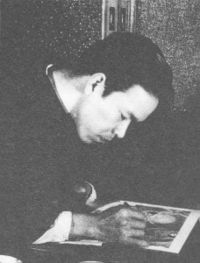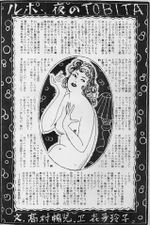Toshiyuki Suma
Suma (須磨) family name, Toshiyuki (利之) first name, (1920-1992)
Toshiyuki Suma played an important role in the formation of post-war SM culture. Suma did editorial work for early SM magazines such as Kitan Club, Uramado, SM Collector, Abu Hunter and SM Kitan. He is also famous for his SM illustrations and left behind a large body of work as a writer and kinbakushi.
Activities
Artist, Editor, Writer, Kinbakushi.
Alternate Name(s)
須磨利之(Japanese), Reiko Kita, Kou Minomura, Kyoji Minota, Eijiro Takenaka[1] etc..
Biography
Since it is believed that Suma's autobiographies include some invented anecdotes, the biographical data below could contain inaccuracies. Therefore, the following biography may be corrected in the future.
1920: Born in Kyoto to a family that ran a printing business out of their home[※ 1][2].
1932(c): As a child, he encountered Seiu Ito's torment art in the book Documentation on Abnormal Customs, which he found in his grandfather's book collection[2][3].
1930s: Left the Kyoto School of Fine Arts at mid term and became the live-in apprentice to the Japanese painter Baisen Kobayashi[※ 2][2][3].
1939: May. Volunteered for the Navy in Maizuru, Kyoto[4].
1944: Mar 18. Suma's ship, the Hokuriku Maru, sank in the Bashi Channel[※ 3].
1945(c): Suma was discharged from the Navy and wandered across Japan and was employed at various jobs before becoming an editorial reporter for the evening newspaper Central Kyoto News.[3].
1947: summer. Kiyoshi Sugiyama, who worked at the Central Kyoto News, took Suma to the editorial office of Kitan Club (Akebono Shobo), which gave Suma a chance to begin drawing illustrations for Kitan Club[※ 4]. There were other irregularly published pulp magazines besides Kitan Club, and Suma drew illustrations for Jouen Shin-syu and others as well.[※ 5][3].
1950: The name "Reiko Kita" and "Toshiyuki Suma" began to appear on Kitan Club[5].
1951: Dec. Began full participation at Kitan Club[5].
1952: Kitan Club changed from a size of A5 to B5 and promoted its "abnormal" content.
1953: Resigned from Kitan Club and published the private fanzine called Tanoshimi Soushi[3][※ 6]. Reiko Kita's art appears in the December issue of Fuzoku Soushi.
1954: Traveled to Tokyo in the autumn of 1954[6][※ 7]. He meets Seiu Ito in person for the first time[※ 8][2][3].
1955: With the cancellation of Fuzoku Soushi, Suma began working for Amatoria magazine (published by Kubo Shoten), and he launched Kappa the predecessor of Uramado.[3][※ 9].
1956: Founded Uramado magazine, published through Kubo Shoten[7].
1959: Intesified his association with Oniroku Dan around this time[Citation needed].
1960: Uramado changed from edge binding to inner binding and championed the "abnormal magazine."
1961: Hiroshi Urado participated in Uramado's editing room.
1962: Passed the editorial baton to Chimuo Nureki, who became Uramado's new editor-in-chief. Worked on editing Light and the girls' magazine Lyric Literature[3].
1970: Suma and Chimuo Nureki left Kubo Shoten and founded Abu Production, where Suma was an executive head. They published Abment which terminated in Sep. 1970.
1970: Nov. Involved in the foundation of SM Select.
1971: Oct. Involved in the foundation of SM Collector.
1970s: Suffered a cerebral aneurysm; received treatment at Spring Sanatorium in Shichi-zawa, Atsuki city, Kanawaga[7].
1989: The documentary video Jouen - The world of Minomura Kou was made by Syoichi Yoshimura. Directed by Haruki Yukimura. Chimuo Nureki, Oniroku Dan, Tetsuro Sakuragi, Go Arisue, Yoji Muku and Syoichi Yoshimura appeared in the video.
1992: Died at the age of 72.
Interesting point(s)
- Suma's nomme de plume of "Minomura Kou" was taken from the Malaysian expression, "A little rest."[7].
- It seems that Suma was commissioned by Edogawa Ranpo to paint a boy's picture[6].
- There is a tape recording of war anecdotes[※ 10] exchanged between Terayama Shuuji and Suma Toshiyuki[6].
- Suma Toshiyuki was a boxing fan. One day, Suma took Chimuo Nureki to a bar called Tako Beya (Tako Room, which means cramped quarter) and told him, "This is a bar run by Kappa Seisaku (Hachiro Tako), a former domestic boxing champion."[8]
- Suma first came into contact with Seiu Ito when Ito wrote to him at Kitan Club and offered his guidance for SM illustrations.
Selected Works
Magazine Articles
- A Great Star Has Fallen (SM Collector, Nov. 1980. Memorial dedication to Seiu Ito)
-
Spring Rope SeriesCite error: Invalid
<ref>tag;
invalid names, e.g. too many) (Monthly serial in S&M Sniper, May 1993 - Jan. 1995)
- Rope Companion Record (Serialized in Kinbiken News, April-May 1990. March - June 1991)
Photo Collections
- Utsukushiki Imashime (1953) Bondage: Kou Minomura. Photography: Tetsuzo Tsukamoto.
References
- ↑ Painted in the style of Eitaro Takenaka. Years later, Suma was visited by Eitaro Takenaka's son, the critic Tsutomu Takenaka.
- ↑ 2.0 2.1 2.2 2.3 Minomura, Kou. "A Great Star Has Fallen." SM Collector Nov. 1980: 96-111. Print.
- ↑ 3.0 3.1 3.2 3.3 3.4 3.5 3.6 3.7 Akio, Fuji, Masami Akita, and Chimuo Nureki. History of Japanese Kinbaku Photography 1. Tokyo: Jiyukokuminsha, 1996. Print.
- ↑ Shimokawa, Koushi. The Paradise Trade - A History of the Essential Nature of Post War Accounts. Tokyo: Chikuma Shobo, 1998. Print.
- ↑ 5.0 5.1 "Kyoji Minota" in SMpedia
- ↑ 6.0 6.1 6.2 Kitahara Dohmu. Tokyo Fetish Club. Tokyo: San'ichi Shobo, 1996. Print
- ↑ 7.0 7.1 7.2 Nureki, Chimuo. The Artists of Kitan Club. Tokyo: Kawade Shobo Shinsha, 2004. Print.
- ↑ Nureki, Chimuo. Nureki Chimuo's Chat Theater #97. 2009. Web. 19 Oct 2009.
Notes
External Links
Cite error: <ref> tags exist for a group named "※", but no corresponding <references group="※"/> tag was found, or a closing </ref> is missing

